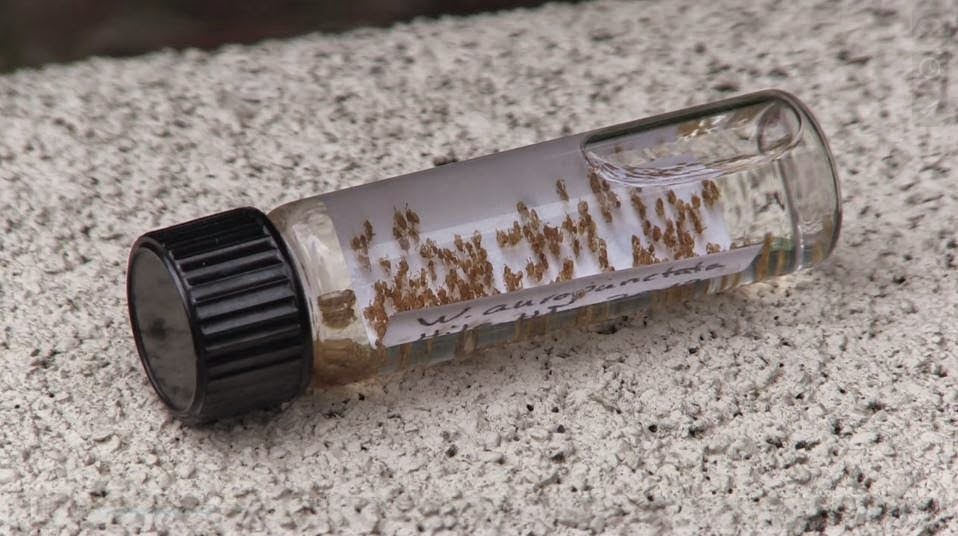 |
Trini and Francis Marques, two of the founders of the Ka`u Coffee industry, moving from sugar plantation work to coffee nearly
two decades ago, took first in the Ka`u division of the Hawai`i Coffee Association 2014 cupping competition.
Photo from Ali`i Hawaiian Hula Hands. |
THE PLIGHT OF KA`U COFFEE GROWERS remains the top story in Ka`u, with some 30 farmers transitioning from 2014 into 2015, with most of their leases expired after nearly two decades of work to build a new economy after the sugar industry shut down in 1996. The farms are within 5,800 acres offered for sale by Lehman Brothers Holdings, which foreclosed on a company that borrowed more than $40 million against the land and planned to subdivide and sell it. They promised that new owners of proposed coffee estates would allow the coffee growers to continue to farm around the houses the new buyers could build. The Project Unit Development that was approved for the subdivision, with numerous infrastructure requirements, is still in place.
However, new rules for approving PUDs were recently passed by the County Council, requiring more public review of the process before approval. In the past, as with the coffee lands, such subdivisions could be approved with smaller than 20-acre lots for which the property is zoned.
Meanwhile, coffee growers thrive, many of them evolving from sugar workers to entrepreneurs, owning their own coffee businesses and homes, representing one of the most successful post-plantation, small business successes for local people in Hawai`i.
Some of these farmers are spreading their land security risk, realizing that new owners could evict them at Moa`ula and Pear Tree. A number of these Ka`u Coffee growers have planted additional coffee farms on Olson Trust land at the mouth of Wood Valley. Hawai`i Farm Bureau President Chris Manfredi said he will advocate for long term leases for the farmers.
Mayor Billy Kenoi and newly elected County Council member Maile David Medeiros have vowed to advocate for land security for the Ka`u Coffee farmers.
To comment on or like this story, go to facebook.com/kaucalendar.
 |
Ka`u Gym and Regional Diaster Shelter nears completion.
Photo by Julia Neal |
REGIONAL SHELTER & GYM NEARS COMPLETION. Known as the biggest gym at one of the smallest public schools in the state, the soon-to-be completed Ka`u gymnasium and disaster shelter will be operated by the county Department of Parks & Recreation for both the public and Ka`u High & Pahala Elementary and Intermediate schools. The nearly $20 million facility will offer multiple playing courts for basketball, volleyball and other sports. It is built with the kind of hardening that allows it to be certified as a disaster shelter for the region. Whether air conditioning and air filtration for the huge gym and shelter, and solar voltaics to support them could be added, is still in question. The facility on county property adjacent to the Pahala school campus was funded with “shovel ready” state and federal money after the 2008 financial collapse in the U.S. economy.
To comment on or like this story, go to facebook.com/kaucalendar.
 |
| Maps of Ka`u land use are at www.kaucdp.info. |
KA`U COMMUNITY DEVELPOMENT PLAN is in draft for public review and provides exhaustive detail on the geography and population of the district. The county-sponsored document, a primer for community members, school students and anyone desiring to know Ka`u, can be read at
www.kaucdp.info and in hard copy at local libraries and community centers. The Ka`u Community Development Plan offers many maps, showing land use, agriculture and other components of Ka`u’s people and place. Community members can also reach out to county planner Ron Whitmore at 961-8137 or
rwhitmore@co.hawaii.hi.us. The public may contact Ka`u Community Development Plan Steering Committee members: Chair Leina`ala Enos, 929-9022; Patti Barry, 937-3124; Bob DaMate, 497-0384; Ron Ebert, 928-0027; Leina`ala Enos, 929-9022; Michelle Galimba, 430-4927; Loren Heck, 939-9454; Eldridge Naboa, 936-2189; Marino Ramones, 928-8240; Simon Torres, Jr., 928-6103; and John Cross, 987-4229.
Issues include a proposed quarter mile development setback along the Ka`u Coast and future zoning for population and economic growth.
To comment on or like this story, go to facebook.com/kaucalendar.
 |
Hawaiian Volcano Observatory scientists stand on new lava behind
olderrocks that got thrown several yards during a methane explosion
in front of the shrub at center. Photo from USGS/HVO |
HAWAIIAN VOLCANO OBSERVATORY, located on the edge of Ka`u in Hawai`i Volcanoes National Park, took on the monumental task of predicting, documenting and studying a lava flow that started June 27 and is threatening Pahoa and other lower Puna communities with destroying homes and businesses and isolating thousands by cutting off roads. By New Years Eve, one home had burned. However, the flowing fingers of lava stopped and stalled as a shopping center shut down and some businesses and families abandoned their buildings. Hawai`i Volcanoes National Park worked with the county and state to open an escape route across an old road from Kalapana into the park that was previously covered with lava.
To comment on or like this story, go to facebook.com/kaucalendar.
 |
New drying towers at Royal Hawaiian Orchards
Photo by Julia Neal |
LOCAL FOOD COMPANIES TOOL UP FOR THE FUTURE. Punalu`u Bake Shop, having won a contract to provide its cookies to Hawaiian Airlines, is near completion of a new cookie kitchen on the grounds of its bakery and visitor center in Na`alehu. Royal Hawaiian Orchards installed 15 drying towers in Pahala to remove moisture from macadamia nuts in the shell before they are shipped and cracked. Ka`u Coffee Mill installed a new double drum pulper which can handle more 30,000 pounds a day. Work continued on a hydroelectric plant slated for completion in late 2015 on Olson Trust lands at the mouth of Wood Valley.
To comment on or like this story, go to facebook.com/kaucalendar.
 |
Ka`u Trojans take the BIIF Championship for eight man football after helping to start the league for smaller schools.
Photo from Ka`u Trojans |
KA`U HIGH TROJANS WIN BIIF CHAMPIONSHIP. Ka`u High School, with one of the smallest campus populations in the state from which to suit up a football team, found a way to be competitive. Athletic Director Kalei Kamohala and coach Kainoa Ke proposed eight-man football, a higher scoring faster paced game with fewer players than traditional football. The idea became a reality in 2013 and in 2014 the Trojans became the Big Island Interscholastic Federation champions.
To comment on or like this story, go to facebook.com/kaucalendar.
 |
The clubhoue at Discover Harbour will be campus for Ka`u Learning Academy
Photo from Ka`u Learning Academy |
A NEW CHARTER SCHOOL ACCEPTS STUDENTS IN KA`U. After several attempts over the years by various community groups, a hui led by Kathryn Tydlacka and Joe Iacuzzo won a state approved charter to open the Ka`u Learning Center. The first campus will be in the old Discovery Harbour Clubhouse, now operated as Gilligan’s Café to raise money for the school. Applications are available online for students grades three through six for the 2015-2016 school year at www.kaulearning.com or call 808-213-1097.
To comment on or like this story, go to facebook.com/kaucalendar.
 |
Kahuku Iki is a new preserve for
The Nature Conservancy
Photo by Shalan Crysdale |
ISELLE MAKES LANDFALL, FOLLOWED BY ANA. Hurricanes usually miss the Big Island, so the legend goes, but Hurricane Iselle came ashore as a weak hurricane or heavy tropical storm on Aug. 8, with the eye passing over the Kamehame hawksbill turtle preserve and Pahala. Wood Valley was cut off as a bridge was destroyed and trees fell onto roads and powerlines. Coffee and macadamia farms suffered fallen cherries, nuts, branches and trees. Hurricane Ana also made landfall as a tropical storm, with more flooding in October.
To comment on or like this story, go to facebook.com/kaucalendar.
 |
Roadworkers clear a path for travel in Wood Valley after
Iselle makes landfall. Photo by Julia Neal |
MORE LAND INTO
CONSERVATION was announced at the end of the year by The Nature Conservancy. The non-profit purchased Kahuku Iki, a 222-acre property between Ocean View and Na`alehu. "Acquisition of the parcel, known as Kahuku Iki, prevents it from being developed and opens the possibility of a future partnership with neighboring Hawaiʻi Volcanoes National Park," said a statement from TNC.
The land was acquired from the real estate company Hulu Lolo, LLC, for $330,000, plus closing costs.
Triangular in shape, Kahuku Iki is zoned Agriculture. Its southerly, makai boundary extends 1.6 miles along Highway 11. Its northerly, mauka boundary is the abandoned old Māmalahoa Highway.
To comment on or like this story, go to facebook.com/kaucalendar.
 |
Bob Herkes receives a lei from Ocean View residents, Mayor Kenoi
and former council member Brittany Smart for his help in
funding the Ocean View well. |
KA`U CHAMPION BOB HERKES passed away on Aug. 21 after a long stint serving the district in the state legislature. Herkes was known for bringing in funding for the Ocean View potable water well and the new Ka`u Disaster Shelter, which will sport his name. He lobbied for a mobile medical van for Ka`u that provides free medical care. He fought for mortgage reform, coming up with some of the strictest foreclosure regulations in the nation. Herkes, a resident of Volcano, was a director of the Hawai`i Tourism Authority and had a career in the hotel industry before turning to community service.
To comment on or like this story, go to facebook.com/kaucalendar.
CHRISTMAS IN THE COUNTRY'S display and sale of holiday wreaths and unique ornaments continues and many diverse works of art continues through Sunday, Jan. 4 at Volcano Art Center Gallery in Hawai`i Volcanoes National Park. Gallery hours are 9 a.m. to 5 p.m. daily. Park entrance fees apply.
KILAUEA MILITARY CAMP in Hawai`i Volcanoes National Park offers New Year’s events. New Year’s Eve party begins tonight at 8 p.m. at KMC’s Lava Lounge, with Mile 25 providing dance music. No cover charge, plus a midnight toast. For more information, call 967-8365.
THE HOLIDAY CHALLENGE at Kilauea Military Camp in Hawai`i Volcanoes National Park ends tonight, New Year’s Eve. The public can judge cottages decorated in holiday lights by KMC employees and vote for their favorites. Park entrance fees apply. Call 967-8371 for more information.
KILAUEA MILITARY CAMP’S Crater Rim Café in Hawai`i Volcanoes National Park follows up its Christmas Day brunch with a New Year’s Day brunch from 8 a.m. to noon tomorrow. Fee for adults is $16.95; $9.50 for children 6-11 years old. Open to authorized patrons and sponsored guests. Park entrance fees apply.
AMAHL & THE NIGHT VISITORS continues at Kilauea Military Camp Theater in Hawai`i Volcanoes National Park. KDEN presents the production this Friday through Sunday, Jan. 4. Showtimes are Fridays and Saturdays at 7:30 p.m. and Sundays at 2:30 p.m. For tickets, call 982-7344 or email
kden73@aol.com.


























































